A Prologue. Fred Douglas Coppock "F. D." 1878 - 1972. An Extraordinary Rich Life. From the days of the horse and buggy to the days of space exploration, Granddad lived the complete life. Married at 19. (Over 70 years caring loving husband father and grandfather. Family patriarch.) At 20 years of age, he founded his first business, which under his leadership becomes the American Aggregates Co. (1950, the largest producer of sand and gravel in the United States.). At age 75, creates, builds, and operates the Miami Seaquarium. (At the time the largest marine aquarium in the world). He was a person of boundless energy. His motto was "work hard, play hard". (Every family member had to work, no slackers). So very creative and inventive. (8 patents, countless engineering innovations). He loved to study history and science. So many projects, for-profit, for nonprofit, or for the environment. His Quaker upbringing greatly influenced being thankful and of his of giving so much back to the community. I had a very special relationship with him, my second father. I will always remember the wonderful times and all that I learned from him. I never heard a negative word, always positive, always caring. (I hope to illustrate the life and times of a most extraordinary person.) |
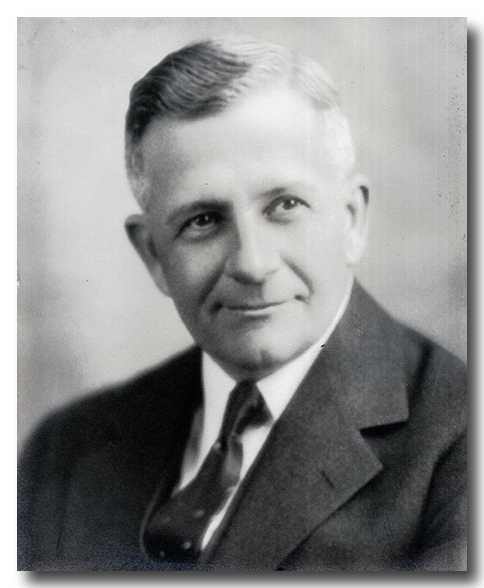 |
|---|
Pleasant Hill Ohio: The Early Years.
Granddad was raised on a farm outside of Pleasant Hill, Ohio. His parents, Allen and Mariah Eugene were Quakers. The Coppock family was among a number of Quaker families, known as the Newberry South Carolina Quakers. Because they were abolitionists, totally against slavery, they were forced to migrate to Pleasant Hill between 1798 -1810. They were the region’s first settlers. Father Allen left the "Quaker-Meeting" to serve with the Union Army in the Civil War. Later he was allowed to rejoin the Quakers. He was a farmer, but also worked as a foreman for the railroad. Mariah Eugene, mother of six, was a strong woman and teacher. The Quakers were well educated entrepreneurs. Somehow, the families could afford to take winter vacations in Florida as early as 1900. At an early age he had experienced another world. He worked hard on the farm. He attended North High School in Columbus, Ohio for one year. No other formal education. In 1897, at age 19, he married Maude (Betty) Miles, age 20. (Like his parents, granddad and grandmother, he lived to be over 90, with 70 years of a wonderful marriage.) In 1900, he borrowed $400 from his father-in-law, John Miles, and started a business close to Pleasant Hill, mining river sand and selling it to contractors to make plaster. In 1902 and 1903, he and John Miles were able to acquire 680 acres south of Fort Jefferson, (now Wayne Lakes). That was the beginning of the gravel business. In 1905 he moved to Greenville. He was followed by a number of family relatives who participated in the business.
Greenville. Pleasant Hill to Greenville: Quaker to Anglican: Farm boy to Leading Citizen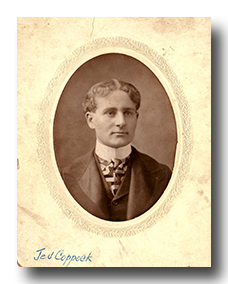
In 1905, Granddad moved to Greenville. Other family members followed, brother Joe, brother Jed, his parents, his sister Maggie Patty's family and his sister Ethel Brown. By 1915, he had built a beautiful house on E. 4th St.. Soon, other family members had constructed similar houses within a two-block radius. He had opened The Greenville Gravel C ompany's downtown office, three blocks from his house. They commuted to the Wayne Lakes operation for 12 and15 hour workdays. They all had various roles with the company. By 1915, they had become one of Greenville's
ompany's downtown office, three blocks from his house. They commuted to the Wayne Lakes operation for 12 and15 hour workdays. They all had various roles with the company. By 1915, they had become one of Greenville's 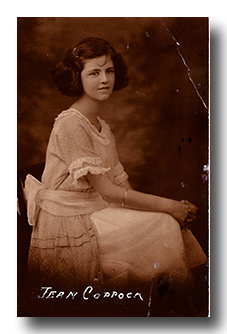 leading families. (Granddad had joined the Episcopal Church, where he played the
leading families. (Granddad had joined the Episcopal Church, where he played the 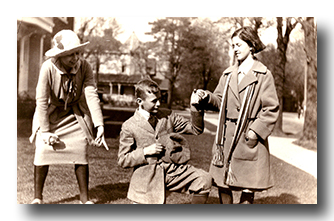 organ.). Early on, Granddad's brother-in-law Omar Patty, had died in an accident at the plant. Granddad cared for Omar's widow, his sister Maggie and her sons. He built a house for his father and mother and cared for them as well as other sisters and brothers. Mother, and her sister Dorothy, enjoyed the wonderful life he created, the beautiful neighborhood, the summers in Canada and Prep school. So many other family members benefited from granddad's help, and the move from Pleasant Hill farm to Greenville's good life. The greatest beneficiary of the Pleasant Hill to Greenville move was Greenville!
organ.). Early on, Granddad's brother-in-law Omar Patty, had died in an accident at the plant. Granddad cared for Omar's widow, his sister Maggie and her sons. He built a house for his father and mother and cared for them as well as other sisters and brothers. Mother, and her sister Dorothy, enjoyed the wonderful life he created, the beautiful neighborhood, the summers in Canada and Prep school. So many other family members benefited from granddad's help, and the move from Pleasant Hill farm to Greenville's good life. The greatest beneficiary of the Pleasant Hill to Greenville move was Greenville!
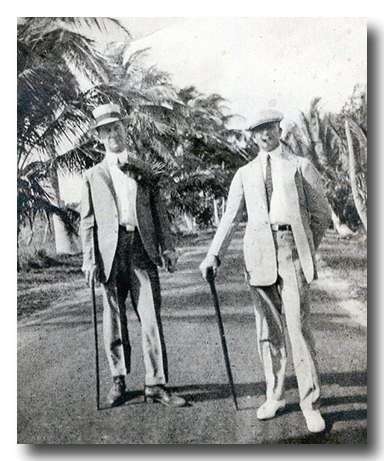 Florida.
Florida.
By 1910, Florida had become the vacation destination for the Coppock, Patty, Miles, Pleasant Hill and Greenville families. Two days train ride to vacations in Jacksonville. For Granddad, certainly fishing was a big attraction. How he went to Cuba the same year, I have no idea. Best trip was during the winter of 1912. That December, Flagler completed the railroad from Miami to Key West. The week after it opened, Granddad took it to Key West and then continued by boat to Havana, Cuba. From Cuba to Puerto Rico and then on to study the construction of the Panama Canal. After that, many trips to Cuba, every winter in Miami. Early days he had small jobs working in the Miami River. There were many Florida projects. In the 30's, he dredged land creating an island that he owned between Miami and Miami Beach. Also, he owned a 76 acre plot on Miami Beach facing the mainland. He had plans to build a center for the " Latin American Nations". (After the war he feared another depression and sold the properties at losses.) In the 30s, he had a lovely home on Miami Beach. In 1946, he and grandmother leased a beautiful suite in the Columbus Hotel on Biscayne Bay*. It was then the center of Miami. It became their second home. Beautiful hotel, wonderful friends. As a child and young adult, I enjoyed many wonderful visits. In 1955, at age 77, he opened the Miami Seaquarium. (I had a summer job at the aquarium in 1958.) Five years later, Ggranddad founded and financed Schultz Marine Construction Company. (I worked two summers for the company, one in Miami and the second in St. Thomas, Virgin Islands; being the best summers). In 1966, after 55 years and Grandmother's death, he stopped wintering in Florida.
* Click link for photo
 |
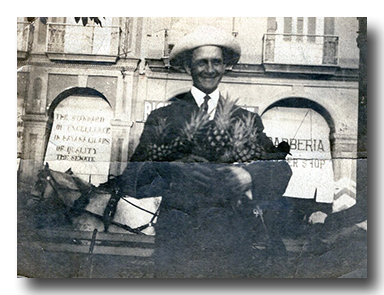 Cuba |
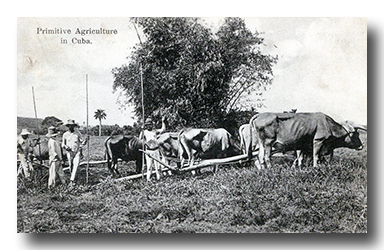 |
|---|
Canada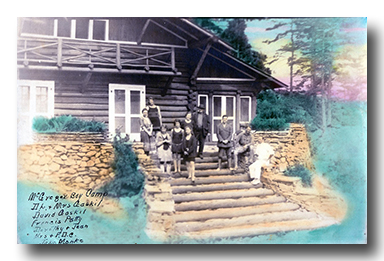
Canadian Projects. Because of his love of fishing, he was one of the first American's to build a Lodge in McGregor Bay, Canada.
I). Main Lodge. He bought his own island in McGregor Bay. Somehow in the 20s, he built a large beautiful Lodge, with a separate guest house and a large boathouse. At an old age, he sold the Lodge to Mr. Briggs of Briggs & Stratton Motors of Detroit.
II) Long Lake or Three Narrows Lake. After an hour motorboat trip to Kirk Creek, then canoeing up Kirk Creek for a couple more hours, I remember finally arriving at the dam.
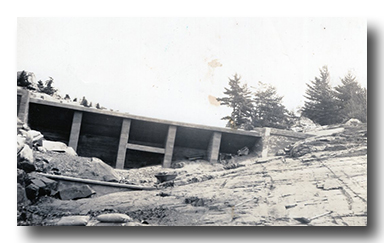 A). The Dam at Three Narrows Lake. Granddad, secured a special act of the Parliament at Ottawa to allow him to erect a large dam at the outlet of Three Narrows Lake. He convinced the parliament it was necessary to save the natural beauty of the area and provide a haven for sportsmen. It was over 30 feet high. How he built this in the wilderness, I'll never know. I remember as a little boy walking across the top of the dam with Granddad, as my Dad watched, horrified.
A). The Dam at Three Narrows Lake. Granddad, secured a special act of the Parliament at Ottawa to allow him to erect a large dam at the outlet of Three Narrows Lake. He convinced the parliament it was necessary to save the natural beauty of the area and provide a haven for sportsmen. It was over 30 feet high. How he built this in the wilderness, I'll never know. I remember as a little boy walking across the top of the dam with Granddad, as my Dad watched, horrified.
B). Fishing Lodges on Three Narrows Lake. 1/4 of a mile from the dam was the first Lodge. It was  seldom occupied. (Another story). A half-mile from there was an actively decorated large lodge (built in 1935). It was built for Aunt Dorothy and Uncle Edward. We would stop there for a late lunch, take the motorboat, towing the canoes, 10 miles, down to Granddad's island. He constructed this for his own personal use. I was some of the best fishing in Canada. He entertained business and sportsmen guests. Members of Uncle Edward's family still own the two lodges today.
seldom occupied. (Another story). A half-mile from there was an actively decorated large lodge (built in 1935). It was built for Aunt Dorothy and Uncle Edward. We would stop there for a late lunch, take the motorboat, towing the canoes, 10 miles, down to Granddad's island. He constructed this for his own personal use. I was some of the best fishing in Canada. He entertained business and sportsmen guests. Members of Uncle Edward's family still own the two lodges today.
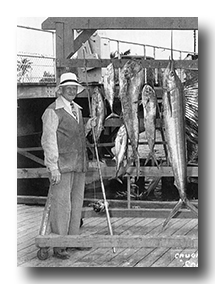
Fishing. From childhood to old age, fishing and hunting were his greatest joys. I hunted quail, pheasant, rabbit, squirrel and of course, mushrooms with Granddad and Dad. But, above all, fishing was his favorite past time. Big game fish in Florida, Canada, Wayne Lakes and local streams. He fished everywhere. Because of his love of fishing, he stocked all of the gravel plant lakes with fish for his employees. Wayne Lakes fishing ponds. He introduced trout into western Ohio's Mad River. Late in life his own fishing reserve, The Hills of Judea, and of course, the Seaquarium.
Greenville Gravel Company. - American Aggregates Corporation.(Must Read)
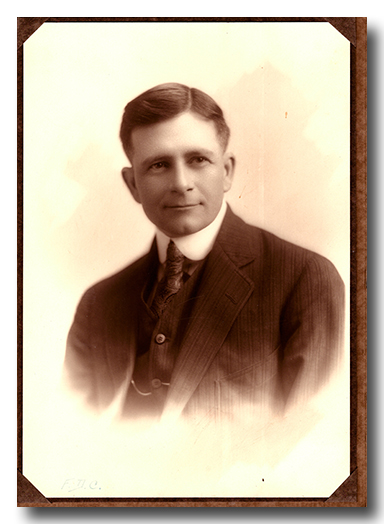 Granddad and his father-in-law John Miles started mining and selling gravel and sand in Miami County in 1899. Granddad was then 21. In 1904, they bought acreage at what is now Wayne Lakes and started a gravel operation.The next year they were joined by Omar Patty Granddad's brother-in-law and Granddad's brother, Joe Coppock in a partnership that acquired remaining acreage.They then incorporated the partnerships, hence the Greenville Gravel Company. (Financial luck! Granddad told me that they had harvested a large amount of walnut logs which they dryed and then sold to Germany to be used for rifle butts. Enough money to retire debt on the property.True story?). The beginning of the gravel industry. The property was rich with glacial gravel deposits. Using manpower and wheelbarrows, they mined and sold sand and gravel to neighboring communities for construction and other projects. (With Henry Ford's invention in 1902 came the greatly expanded need for improved roadways, hence a much greater demand for gravel. And then later, of course, for concrete and blacktop, as roads improved.) The timing was perfect. By 1908 the business had expanded so much that they were able to purchase a "gigantic" 1 1/4 yd.³ Marion steam shovel, Old Nancy. The company expanded rapidly with other plants. In 1928, the Greenville Gravel Company and its many subsidiaries combined to form the American Aggregates Corporation. In 1963, 85 years old, Granddad retired as chairman
Granddad and his father-in-law John Miles started mining and selling gravel and sand in Miami County in 1899. Granddad was then 21. In 1904, they bought acreage at what is now Wayne Lakes and started a gravel operation.The next year they were joined by Omar Patty Granddad's brother-in-law and Granddad's brother, Joe Coppock in a partnership that acquired remaining acreage.They then incorporated the partnerships, hence the Greenville Gravel Company. (Financial luck! Granddad told me that they had harvested a large amount of walnut logs which they dryed and then sold to Germany to be used for rifle butts. Enough money to retire debt on the property.True story?). The beginning of the gravel industry. The property was rich with glacial gravel deposits. Using manpower and wheelbarrows, they mined and sold sand and gravel to neighboring communities for construction and other projects. (With Henry Ford's invention in 1902 came the greatly expanded need for improved roadways, hence a much greater demand for gravel. And then later, of course, for concrete and blacktop, as roads improved.) The timing was perfect. By 1908 the business had expanded so much that they were able to purchase a "gigantic" 1 1/4 yd.³ Marion steam shovel, Old Nancy. The company expanded rapidly with other plants. In 1928, the Greenville Gravel Company and its many subsidiaries combined to form the American Aggregates Corporation. In 1963, 85 years old, Granddad retired as chairman 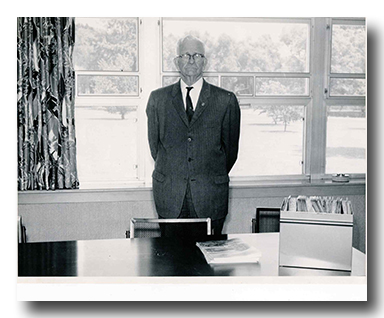 of the board. At that time, American Aggregates Corporation had become the largest sand and gravel company in the United States. It had 22 plants with operations in Ohio, Indiana and Michigan. It produced 15 million tons of sand and gravel and slang aggregates per year. It's subsidiaries included Grant Dredging Company. (This company was one of Granddad's favorite ideas.) It performed large dredging operations on the Ohio and Mississippi Rivers, from Cincinnati to New Orleans.The Greenville Manufacturing Company, a large facility built in 1918 in Greenville, served as a major repair facility and manufactured a wide array of parts and products used by the company's plants or sold others. (One product was large metal barges used for gold mine dredging operations in California. They were used in the Second World War to build pontoon bridges in Germany.)
of the board. At that time, American Aggregates Corporation had become the largest sand and gravel company in the United States. It had 22 plants with operations in Ohio, Indiana and Michigan. It produced 15 million tons of sand and gravel and slang aggregates per year. It's subsidiaries included Grant Dredging Company. (This company was one of Granddad's favorite ideas.) It performed large dredging operations on the Ohio and Mississippi Rivers, from Cincinnati to New Orleans.The Greenville Manufacturing Company, a large facility built in 1918 in Greenville, served as a major repair facility and manufactured a wide array of parts and products used by the company's plants or sold others. (One product was large metal barges used for gold mine dredging operations in California. They were used in the Second World War to build pontoon bridges in Germany.)
Allied Cloth Company made mainly canvas products. (On a trip to New York City, Granddad saw the need, and convinced Rockefeller Center to buy canvas slipcovers for the beautiful velvet seats for matinee performances of the Rockettes) .
Permacreet Products Inc. With gravel came concrete. Granddad had a number of inventions and uses for concrete. This company manufactured a large array of concrete products, from concrete blocks to large concrete rafter-like beams for buildings. It had major plants in Columbus Ohio, Chicago, Illinois and Greenville.
Omort Trucks. (Must-read material). In the very early years, Granddad designed one of the country's first dump trucks. It was used to haul gravel and then spread it on country dirt roads. (During the Second World War, he showed me his design to build a low cost automobile to be manufactured after the war with the top made of canvas by the Allied Cloth Company and the vehicle by OMORT! Never happened, but he was always inventing and creating.).
Most Important! (Must-read the attached materials.) Most important is the Rock Products Magazine January 1951 issue. Second, read Omort Truck literature. Also read the article, "American Aggregates Puts Customer First".
The Miami Seaquarium.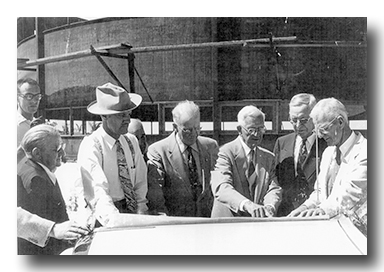
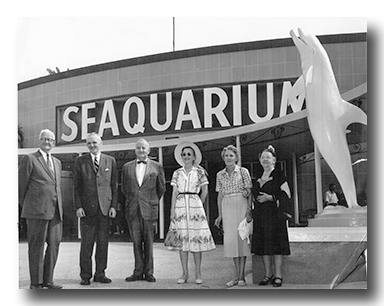 The Miami Seaquarium opened in September 1955. At the time, it was the largest ocean aquarium in the world. Granddad was 77 years old. He wintered in Florida his entire adult life. While still Chairman of American Aggregates, he was inactive in the winter. He needed a project. He conceived the idea of the aquarium, designed all aspects of it and organized the Corporation. He dredged and reclaimed the land. He enlisted many good friends (including the actor, James Stewart) to finance the the Seaquarium Corporation. He hired away from the other Florida aquarium, Marineland, Capt. Gray, who was the country's leading "procurer" of marine species. He served as Chairman of the Board and President. He actively participated in all aspects of the operation. At the beginning, he
The Miami Seaquarium opened in September 1955. At the time, it was the largest ocean aquarium in the world. Granddad was 77 years old. He wintered in Florida his entire adult life. While still Chairman of American Aggregates, he was inactive in the winter. He needed a project. He conceived the idea of the aquarium, designed all aspects of it and organized the Corporation. He dredged and reclaimed the land. He enlisted many good friends (including the actor, James Stewart) to finance the the Seaquarium Corporation. He hired away from the other Florida aquarium, Marineland, Capt. Gray, who was the country's leading "procurer" of marine species. He served as Chairman of the Board and President. He actively participated in all aspects of the operation. At the beginning, he 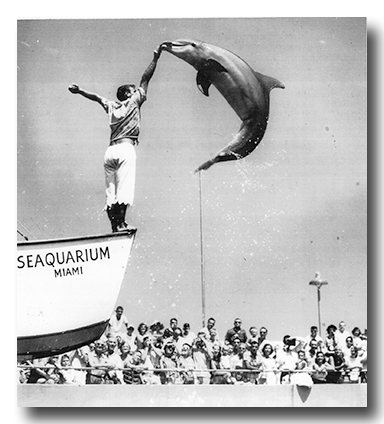 landscaped the property. He solved problems with the Management of Water. He took particular
landscaped the property. He solved problems with the Management of Water. He took particular 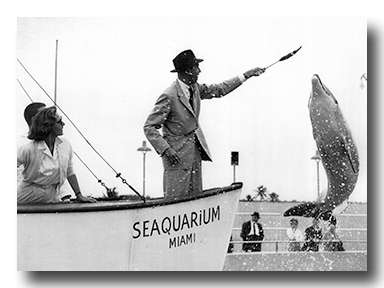 interest in animal training and enhancing and creating the shows. He especially enjoyed working with Capt. Gray and the collection of specimens and the creation of the boat and equipment used. By 1957, it was ranked as the best marine exhibit in the world. Unfortunately, five years after the beginning, problems with a major partner created the necessity to sell the Seaquarium. (I worked there in the summer of 1957, a great experience.) I remember earlier when granddad started designing much of the facility in his room at the Columbus Hotel.
interest in animal training and enhancing and creating the shows. He especially enjoyed working with Capt. Gray and the collection of specimens and the creation of the boat and equipment used. By 1957, it was ranked as the best marine exhibit in the world. Unfortunately, five years after the beginning, problems with a major partner created the necessity to sell the Seaquarium. (I worked there in the summer of 1957, a great experience.) I remember earlier when granddad started designing much of the facility in his room at the Columbus Hotel.
Bones and Schultz Marine Construction
Having sold the Miami Seaquarium, Granddad wanted yet another enterprise. In 1955, at age 81, he formed the Marine Construction Company, Bones and  Schultz. He gave me, at a great discount, significant share of the stock. (I think because I never was allowed to have an opportunity to work for the American Aggregates, because of Uncle Edward, he wanted me to have a business.) For the first two years, the company operated in the Miami Beach area. I worked there, parts of two summers. We built docks, piers and sea walls. Granddad then moved the operation to St. Thomas, American Virgin Islands. It had won the contract to build the piers between St. Thomas and St. John's. A big job. I spent over two months of the summer after my freshman year in law school working with the crew. Upon return, I told Granddad that I thought the new CEO, wasn't straight up. Granddad had an audit, found the fraud, and closed down the company. He lost quite a sizable sum of money. (Later, Granddad asked me if I would go to the Amazon. He had a deal to trade the equipment from the company for a large stand of timber in Brazil.) End of my construction career. However, I had one of my best summer's ever.
Schultz. He gave me, at a great discount, significant share of the stock. (I think because I never was allowed to have an opportunity to work for the American Aggregates, because of Uncle Edward, he wanted me to have a business.) For the first two years, the company operated in the Miami Beach area. I worked there, parts of two summers. We built docks, piers and sea walls. Granddad then moved the operation to St. Thomas, American Virgin Islands. It had won the contract to build the piers between St. Thomas and St. John's. A big job. I spent over two months of the summer after my freshman year in law school working with the crew. Upon return, I told Granddad that I thought the new CEO, wasn't straight up. Granddad had an audit, found the fraud, and closed down the company. He lost quite a sizable sum of money. (Later, Granddad asked me if I would go to the Amazon. He had a deal to trade the equipment from the company for a large stand of timber in Brazil.) End of my construction career. However, I had one of my best summer's ever.
Wayne Lakes. 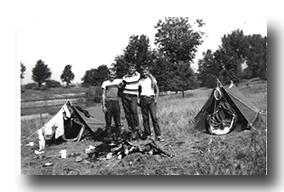
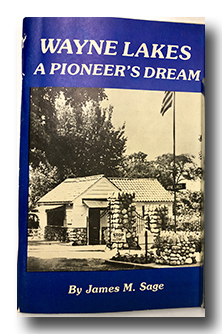
Reclamation of the best sort. After the completion of the mining of the gravel land reclamation, and forming the lakes, in the late 1920's, Granddad had the brilliant idea of making a vacation community. (It opened in 1931). He then created a swimming pool facility and a master meeting log house. He then proceeded to subdivide the entire property. It was one of the first of its kind in the country. He also used it as his fish hatchery for the American Aggregates's different properties. To this day, it is a thriving small community. (Before he built the Hills of Judea, we enjoyed the north section of Wayne Lakes as our private family reserve. Wonderful fishing and camping. The attached materials are a must-read). ⏎ Read the book.
The Park.
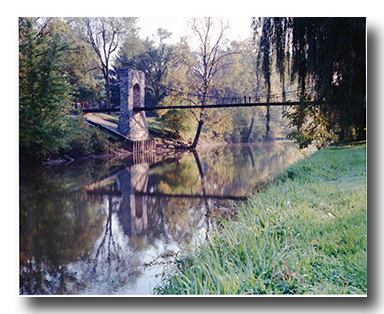
Between the town and the city park was a large tract of land, a landfill and dump. Granddad, in the late 1930's, reclaimed the land. He built the levees on both sides of the Greenville Creek. He built the Swinging Bridge over the creek. He built the ponds, the out-of-door's stage, the Girl Scout house in 1941 (across from my parent’s house) and later, the Boy Scout facility. In the 1950's, it became the site of the Masonic Lodge. When he began, people in Greenville called it "Coppock's Folly". Some Folly! In later years, the Park combined with the old city park and created an extraordinarily useful and beautiful area facility for a small town. The early days every summer, he would sponsor a large Boy Scout camp-out. Boy Scouts from all over Western Ohio would camp for a great, long weekend event. He also erected the monument for the Treaty of Greenville on the town edge of the park; many commemorative ceremonies. Most importantly, the Park is where I grew up with my neighbor Bill Browne. The best of places!
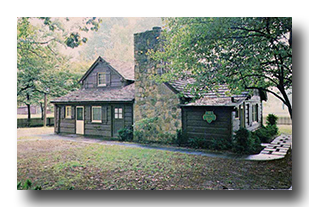 |
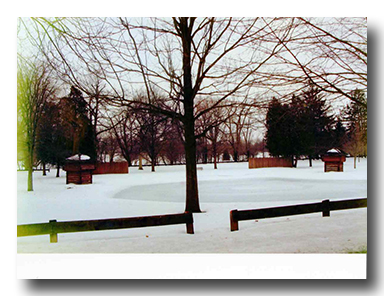 |
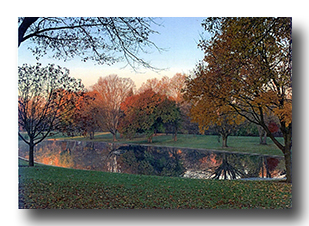 |
|---|
 Garst Museum.
Garst Museum.
Granddad and Dad were both avid historians. (Ohio Gov. Lausche appointed Granddad to the Board of Trustees of the Ohio Historical and Archaeological Society. He served six years.) Their combined efforts made the Garst Museum happen. The Museum now comprises the original Garst house and five large display buildings. Dad was chairman of the founding committee for the Darke County Historical Society. Granddad, with Jake Menke, close friend and member of the Garst family, procured the first building. In the 1800's, it had been a small guest house-hotel. Their first mission was to house the treasures held by the Historical Society, which were poorly housed in the basement of the Carnegie Library. Granddad, in 1965, financed and designed the second building, the Coppock Wing. It is adjacent to the original house. It originally housed the Annie Oakley and Lowell Thomas collections. Now it's just the Annie Oakley collection. (Granddad also financed the Howard Chandler Christie large mural painting of the Treaty of Greenville that hangs in the Ohio State Capital. Christie's preliminary rendition is on display at the museum). Adjacent is the Brumbaugh Wing, a large building, financed by Dad and Mother. It originally displayed a mixture of early county utensils and art. It now houses the Lowell Thomas collection, art, and other Darke County treasures. The third facility, a long hallway, was financed by Mother's cousin, Margaret Brown Ullery. The third largest building was dedicated by Margaret's brother, Pete Brown. Pete managed the museum for years. Later, two other large halls were built, the last of which our family made a significant contribution. About 10 years ago, I undertook to redo the original Garst House and the Coppock and Brumbaugh Wings. It was a significant undertaking. Recently, I and the Coppock-Hole Family Trust have been financing needed repairs. For the last six years, the Museum, which is the seventh largest in the state of Ohio, has been ranked the number one Museum in the state. A must visit!
originally housed the Annie Oakley and Lowell Thomas collections. Now it's just the Annie Oakley collection. (Granddad also financed the Howard Chandler Christie large mural painting of the Treaty of Greenville that hangs in the Ohio State Capital. Christie's preliminary rendition is on display at the museum). Adjacent is the Brumbaugh Wing, a large building, financed by Dad and Mother. It originally displayed a mixture of early county utensils and art. It now houses the Lowell Thomas collection, art, and other Darke County treasures. The third facility, a long hallway, was financed by Mother's cousin, Margaret Brown Ullery. The third largest building was dedicated by Margaret's brother, Pete Brown. Pete managed the museum for years. Later, two other large halls were built, the last of which our family made a significant contribution. About 10 years ago, I undertook to redo the original Garst House and the Coppock and Brumbaugh Wings. It was a significant undertaking. Recently, I and the Coppock-Hole Family Trust have been financing needed repairs. For the last six years, the Museum, which is the seventh largest in the state of Ohio, has been ranked the number one Museum in the state. A must visit!
The Greenville Town Circle.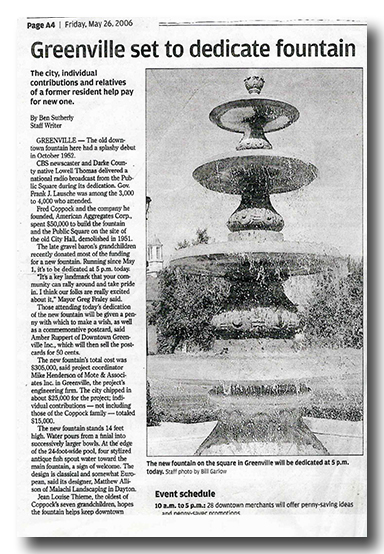
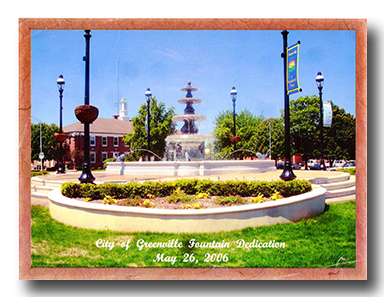
The Fountain. The old Greenville Square was the site of the city courthouse. It was in a shambles. Grandmother convinced Granddad to take action. Granddad, Uncle Edward and American Aggregates provided the money to demolish the old courthouse and buy the adjacent James Hotel and demolish it. Granddad designed and constructed a beautiful fountain and circle. About 2005, the circle had deteriorated. Cousin Jean Louise Thieme enlisted the rest of the family to donate and in Granddad's memory restored the circle.
The Hills of Judea.
The Hills of Judea was the original name of Wayne Lakes. When the first soldiers, in 1792, headed towards Fort Jefferson, they passed this unique area of springs, sand dunes and even an Indian mound. It was very different than the rest of the landscape, hence the biblical name. When Granddad was no longer able to go to Canada, he had American  Aggregates reclaim the three lakes, landscape the property, and build a beautiful cabin. (Of course he helped design the cabin). Naturally, he named it Wayne Lakes. The lakes were very well-stocked. One of my early jobs was to shoot the muskrats that were destroying the banks of the lakes. (Granddad loved to entertain there. Many family picnics and parties. I met Lowell Thomas and Potter Stewart, who later became a United States Supreme Court Justice there. His father, James Stewart, was a former Mayor of Cincinnati and Chief Justice of the Ohio Supreme Court. He was Granddad's longtime lawyer and close fishing buddy). After Granddad's death, the American Aggregates sold the property. My cousins, Jean Louise and Mike Thieme owned the northern two lakes and built a beautiful home. The southern part of the property comprised two lots. The center lot contained the cabin that Granddad built and a party barn that the new owner built. Jean Louise and I bought the property. I enjoyed it for many years as one of my homes. I always stayed there when in Greenville. We had many parties in the party barn. (Second National Bank staff, Nelson Tree Service staff and clients, even two Greenville High School class reunions.) We spent many days fishing and mushroom hunting. For me it is a very special place. After nearly 20 years, I sold my half interest in the property to Jean Louise's daughter, Becky Hartnagle. Still in the family, my deal with Becky was that I could always stay there, if I behaved myself and with proper notification. I still enjoy it from time to time.
Aggregates reclaim the three lakes, landscape the property, and build a beautiful cabin. (Of course he helped design the cabin). Naturally, he named it Wayne Lakes. The lakes were very well-stocked. One of my early jobs was to shoot the muskrats that were destroying the banks of the lakes. (Granddad loved to entertain there. Many family picnics and parties. I met Lowell Thomas and Potter Stewart, who later became a United States Supreme Court Justice there. His father, James Stewart, was a former Mayor of Cincinnati and Chief Justice of the Ohio Supreme Court. He was Granddad's longtime lawyer and close fishing buddy). After Granddad's death, the American Aggregates sold the property. My cousins, Jean Louise and Mike Thieme owned the northern two lakes and built a beautiful home. The southern part of the property comprised two lots. The center lot contained the cabin that Granddad built and a party barn that the new owner built. Jean Louise and I bought the property. I enjoyed it for many years as one of my homes. I always stayed there when in Greenville. We had many parties in the party barn. (Second National Bank staff, Nelson Tree Service staff and clients, even two Greenville High School class reunions.) We spent many days fishing and mushroom hunting. For me it is a very special place. After nearly 20 years, I sold my half interest in the property to Jean Louise's daughter, Becky Hartnagle. Still in the family, my deal with Becky was that I could always stay there, if I behaved myself and with proper notification. I still enjoy it from time to time.
Federal Land Bank.
Granddad was a member of the board and Chairman of the Fourth District Federal Land Bank in Louisville, Kentucky. He served seven years. This was very important during the depression as it served depressed for farming industry. At the time of the most important position.

Wayne Hospital.
In the late 1950's, the hospital added a second building, the Anderson Wing, a $500,000 addition. Granddad was the main donor and gave substantial money for rooms and equipment. Dad, Mother, Fred, Martha and Hilda each gave a room.
Ohio National Guard Armory.
Granddad, through the Greenville Manufacturing Company, a subsidiary of the American Aggregates contributed much to the war effort. For example, they adapted barges the company had been selling to gold mining operations in California to be used for pontoon bridges across German rivers. They also made numerous canvas and cloth products for the war effort. After the war, in the 50's, he contributed substantial monies to help build the National Guard Armory on the north end of Greenville. In 1957, the VFW, Veterans of Foreign Wars honored Granddad with "Ohio's Outstanding Citizen" Award.
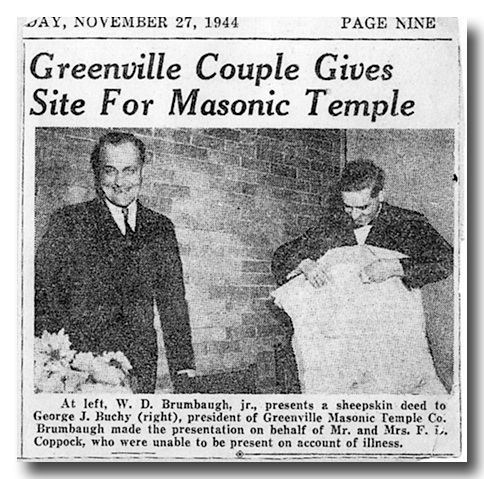
Masonic Lodge.
In the late 1950's, or early 60's, Granddad donated the land and provided significant funds, along with my father to construct the Masonic Lodge at the eastern end of the Park. A large beautiful building, W. D. made the dedication. Granddad, because of his involvement with the Masons and his contributions, had been made a 33° Mason. Top honor.
Greenville Country Club.
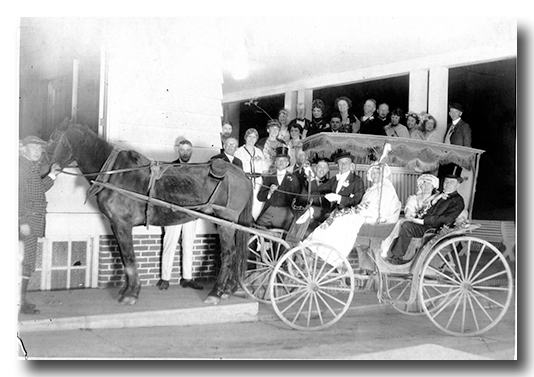
Granddad (1921) was chairman of the Greenville Country Club Founding Committee. He procured the land and made substantial donations. (He told me how he went to Toledo to meet the architect of the famous Toledo Country Club Inverness.) It was a beautiful clubhouse. It burned down in 1950 when we were in Naples, Florida. Granddad gave most of the money for the building of the second clubhouse. (He was the first club champion, wonder why?). (Golf was important in those days for meeting business customers and associates. Mother, however, thought it was a waste of time. I never was allowed to have time to learn to play the game.)
Fort Jefferson State Park.
After only a couple of years in Greenville, he gave the state land adjacent to Wayne Lakes for the formation of the Fort Jefferson State Park. It was the first of his many charitable gifts. The history of the Fort is most important. In 1791, General St. Clair and 2200 soldiers built and occupied the fort. They then marched to their famous defeat at Fort Recovery. Friends of mine are currently doing archaeological studies at the site.
| Photogallery | Memories of F.D. Coppock |
|---|
| Index |